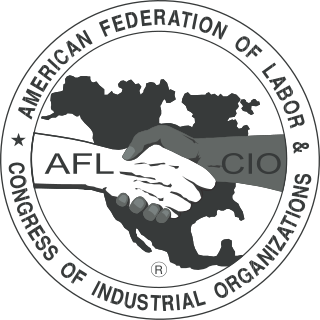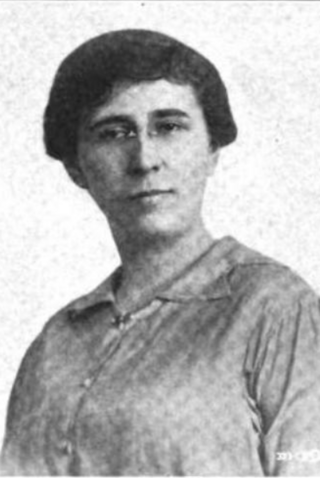The Baltimore Federation of Labor (BFL), an affiliate of the American Federation of Labor, was formed in 1883, in Baltimore, Maryland. [1]
In 1919, the Baltimore Federation of Labor helped found the Baltimore Labor College as an outgrowth of its adult education department. [2]
The Baltimore Federation of Labor was considered conservative. It was allied with the United Garment Workers of America. In 1913, it had a battle with the Wobblies for representation of Baltimore garment industry workers. [3]

Maryland is a state in the Mid-Atlantic region of the United States. It borders Virginia, West Virginia, and Washington, D.C. to its south and west; Pennsylvania to its north; and Delaware and the Atlantic Ocean to its east. With a total land area of 12,407 square miles (32,130 km2), Maryland is the 8th-smallest state by land area. Its population of 6,177,224 ranks it the 18th-most populous state and the 5th-most densely populated. Baltimore is the largest city in the state, and the capital is Annapolis. Among its occasional nicknames are Old Line State, the Free State, and the Chesapeake Bay State. It is named after Henrietta Maria, the French-born queen of England, Scotland, and Ireland, who was known then in England as Mary.

The American Federation of Labor and Congress of Industrial Organizations (AFL–CIO) is the largest federation of unions in the United States. It is made up of 60 national and international unions, together representing more than 12 million active and retired workers. The AFL–CIO engages in substantial political spending and activism, typically in support of progressive and pro-labor policies.

The American Federation of Labor was a national federation of labor unions in the United States that continues today as the AFL–CIO. It was founded in Columbus, Ohio, in 1886 by an alliance of craft unions eager to provide mutual support and disappointed in the Knights of Labor. Samuel Gompers was elected the full-time president at its founding convention and was re-elected every year except one until his death in 1924. He became the major spokesperson for the union movement.

The Communications Workers of America (CWA) is the largest communications and media labor union in the United States, representing about 700,000 members in both the private and public sectors. The union has 27 locals in Canada via CWA-SCA Canada representing about 8,000 members. CWA has several affiliated subsidiary labor unions bringing total membership to over 700,000. CWA is headquartered in Washington, D.C., and affiliated with the AFL–CIO, the Strategic Organizing Center the Canadian Labour Congress, and UNI Global Union. The current president is Chris Shelton.
Amalgamated Clothing Workers of America (ACWA) was a United States labor union known for its support for "social unionism" and progressive political causes. Led by Sidney Hillman for its first thirty years, it helped found the Congress of Industrial Organizations. It merged with the Textile Workers Union of America (TWUA) in 1976 to form the Amalgamated Clothing and Textile Workers Union (ACTWU), which merged with the International Ladies' Garment Workers' Union in 1995 to create the Union of Needletrades, Industrial and Textile Employees (UNITE). UNITE merged in 2004 with the Hotel Employees and Restaurant Employees Union (HERE) in 2004 to create a new union known as UNITE HERE. After a bitter internal dispute in 2009, the majority of the UNITE side of the union, along with some of the disgruntled HERE locals left UNITE HERE, and formed a new union named Workers United, led by former UNITE president Bruce Raynor.

The United Brotherhood of Carpenters and Joiners of America, often simply the United Brotherhood of Carpenters (UBC), was formed in 1881 by Peter J. McGuire and Gustav Luebkert. It has become one of the largest trade unions in the United States, and through chapters, and locals, there is international cooperation that poises the brotherhood for a global role. For example, the North American Chapter has over 520,000 members throughout the continent.
The Amalgamated Clothing and Textile Workers Union (ACTWU) was a labor union representing workers in two related industries in the United States.

The NewsGuild-CWA is a labor union founded by newspaper journalists in 1933. In addition to improving wages and working conditions, its constitution says its purpose is to fight for honesty in journalism and the news industry's business practices. The NewsGuild-CWA now represents workers in a wide range of roles including editorial, technology, advertising, and others at newspapers, online publications, magazines, news services, and in broadcast. The current president is Jon Schleuss.
The National Labor College was a college for union members and their families, union leaders and union staff in Silver Spring, Maryland. Established as a training center by the AFL–CIO in 1969 to strengthen union member education and organizing skills, NLC became a degree-granting college in 1997 and in March 2004 gained accreditation from the Middle States Commission on Higher Education. Until the college closed on April 26, 2014, it was the only college of its kind in the United States.
The Rand School of Social Science was formed in 1906 in New York City by adherents of the Socialist Party of America. The school aimed to provide a broad education to workers, imparting a politicizing class-consciousness, and additionally served as a research bureau, a publisher, and the operator of a summer camp for socialist and trade union activists.
The Journeymen Cigar Makers' International Union of America (CMIU) was a labor union established in 1864 that represented workers in the cigar industry. The CMIU was part of the American Federation of Labor from 1887 until its merger in 1974.
Maryland Steel, in Sparrows Point, Maryland, US, was founded in 1887. It was acquired by Bethlehem Shipbuilding Corporation in 1916 and renamed as the Bethlehem Sparrows Point Shipyard. The shipyard was sold in 1997 to Baltimore Marine Industries Inc.. In 2012, it was owned by Barletta Industries, which had converted it to the Sparrows Point Shipyard and Industrial Complex. As of 2021, it is owned by Sparrows Point Terminal, LLC and has been renamed Tradepoint Atlantic.

Fannia Mary Cohn was a leading figure in the International Ladies' Garment Workers' Union (ILGWU) during the first half of the 20th century. She is remembered as one of the pioneers of the workers' education movement in the United States and as a prolific author on the theme of trade union education.
Mark Starr was a British American labor historian and pedagogue. For 25 years he was educational director of the International Ladies Garment Workers Union.
Angela Bambace was an Italo-Brazilian-American labor union organizer for the International Ladies Garment Workers Union for over fifty years.
The United Hatters, Cap and Millinery Workers International Union (1934–1983), also known by acronyms including UHCMW, U.H.C. & M.W.I.U. and UHC & MWIU, was a 20th-century American labor union.

The Walter P. Reuther Library, Archives of Labor and Urban Affairs, located on the campus of Wayne State University in Detroit, Michigan, contains millions of primary source documents related to the labor history of the United States, urban affairs, and the Wayne State University Archives. The building is named for UAW President and Congress of Industrial Organizations President Walter Reuther.

The Industrial Union of Marine and Shipbuilding Workers of America (IUMSWA) was an American labor union which existed between 1933 and 1988. The IUMSWA was first organised at the New York Shipbuilding Corporation shipyard in Camden, New Jersey after striking in 1934 and 1935. From here it slowly spread to a number of other private shipyards in the Northeast, gaining representation at the Staten Island shipyard in 1936, the Federal Shipyard in 1937, Brooklyn and Hoboken in 1939, Baltimore and Sparrows Point in 1941, as well as a range of other smaller ship repair yards in the New York area. The IUMSWA's industrial coverage of all production workers in the shipbuilding industry brought it into conflict with established craft unions, such as the boilermakers, leading the IUMSWA to be refused an AFL charter in 1933. The IUMSWA later joined the Congress of Industrial Organizations in 1936.
Elias Lieberman (1888–1969) was a Russian-born, 20th-century American labor lawyer who spent his career in the service of the International Ladies Garment Workers Union (ILGWU) and became known as the "Dean of American Labor Lawyers."
The Baltimore Labor College of Baltimore, Maryland, was an early 20th-century college or school or enterprise for workers' education within the State of Maryland. Its president was Polish-born ILGWU organizer William Ross (1899-???).